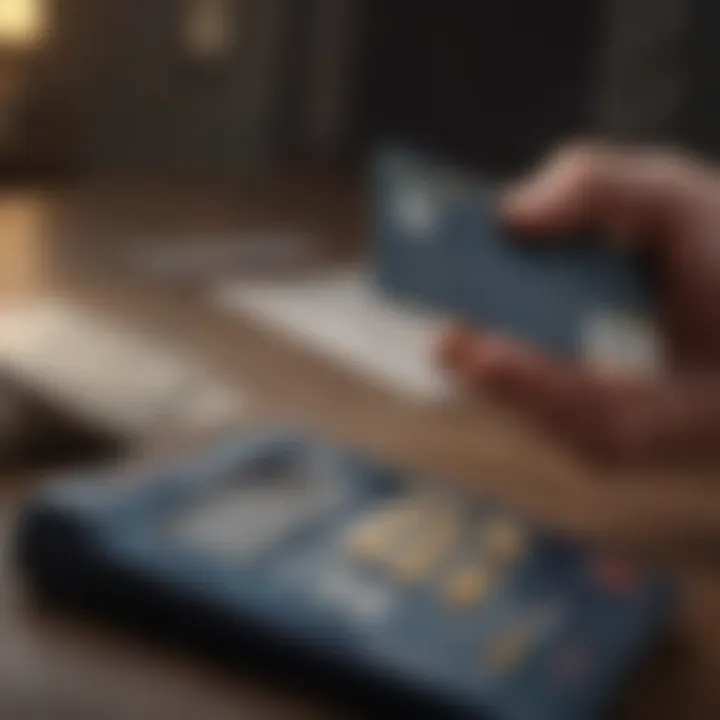Effective Strategies for Paying Off Credit Card Debt


Intro
Managing credit card debt can often feel like walking a tightrope. One moment, you’re riding high on the benefits of rewards points or cashback, and the next moment, those seemingly harmless purchases turn into a mountain of unpaid bills. The stress of credit card debt can weigh heavily on one’s mind and finances, and if not handled properly, can lead to long-term consequences.
In this article, we will look into effective strategies for paying off your credit card balances. Through a mix of practical tips and behavioral insights, we aim to equip you with the tools you need to conquer your credit card obligations efficiently. It’s all about making informed choices, understanding how your credit card usage affects your overall financial health, and developing a robust plan for repayment. By avoiding common pitfalls and embracing sound repayment methods, individuals can achieve not just debt freedom but also a more stable financial future.
Understanding Credit Card Debt
In today’s complex financial landscape, grasping the concept of credit card debt is paramount. More than just numbers on a statement, credit card debt embodies the cultivation of habits and financial behaviors that can either uplift or drag down one’s economic well-being. Understanding this topic lays the groundwork for making informed decisions about repayment strategies and overall financial health.
One significant aspect to recognize is how credit cards function. They can be tools for convenience, but they can also lead individuals into financial traps if not managed wisely. Having a grip on the nuances of credit card usage means knowing when and how to wield its benefits without succumbing to high-interest charges.
The Nature of Credit Cards
Credit cards are, in essence, a double-edged sword. On one hand, they offer convenience, allowing for immediate access to funds at the swipe of a card or tapping a phone. But what often gets overlooked is the myriad of terms and conditions attached to these seemingly harmless pieces of plastic.
When used responsibly, credit cards can help foster a solid credit history, which is indispensable when applying for bigger loans or mortgages. However, misuse or over-reliance can spiral quickly into costly debt. The temptation to overspend is strong; after all, it feels less tangible than handing over cash. Moreover, a credit card enables the luxurious appeal of making purchases beyond one’s immediate means.
Interest Rates and Fees
Ah, the notorious interest rates—often the villain in the tale of credit card debt. These rates can vary widely between lenders and can boggle the mind. The annual percentage rate (APR) represents the cost of borrowing money but understanding that it can change depending on your creditworthiness is crucial.
Fees add another layer of complexity. Whether it's annual fees, late payment charges, or foreign transaction fees, these additional costs can sneak up and compound your debt with alarming speed.
"The real key to avoiding credit card debt is not just about being aware of your spending; it's about knowing how to leverage what you can afford without being led astray by enticing offers and hidden fees."
To keep your credit card use under control, consider these points when evaluating interest rates and fees:
- Read the fine print: Terms can vary; knowing what's at stake is essential.
- Avoid cash advances: These often carry higher interest rates and fees.
- Pay on time: Late payments could cost you more than just the fee; they can also increase your APR.
- Utilize rewards wisely: Don’t chase rewards at the expense of your financial health.
Overall, understanding the nature of credit cards and the associated costs means arming yourself with knowledge that can ultimately lead you to smarter financial decisions and a clearer path to paying off that credit card debt.
Assessing Your Financial Situation
Understanding your financial situation serves as the foundational bedrock for any successful debt repayment strategy. Before diving headlong into payment plans or balancing budgets, it's pivotal to take a step back and carefully evaluate where you currently stand financially. This includes gathering insights into your total debts, income, and expenses, allowing you to forge a tailored path toward eliminating credit card debt.
Calculating Total Debt
A precise understanding of your total debt is not only beneficial; it's essential. When you know the exact figures, it helps you map your repayment strategy effectively. Start by listing out all your credit cards along with their respective balances, interest rates, and due dates. Don’t forget to include other debts such as personal loans, student loans, or any outstanding payment obligations. This comprehensive view of your financial commitments will illuminate your overall financial landscape.
Consider the following steps while you’re calculating:
- Create a spreadsheet: Input each creditor, amount owed, interest rates, and payment due dates for a clear overview.
- Check your credit report: Obtain a free copy of your report from sites like AnnualCreditReport.com to ensure you haven’t overlooked any accounts.
Once you have your total debt figured, you can prioritize which debts to tackle first, play around with repayment methods—be it the snowball or the avalanche—and make informed decisions. An organized summary of your debts can add clarity to what might feel like a chaotic and overwhelming situation.
Evaluating Monthly Income and Expenses
After you’ve painted a picture of your debt, it’s equally crucial to scrutinize your monthly income and outgoing expenses. This evaluation acts as a guiding light, illuminating how much of your earnings can realistically be allocated toward debt repayment. It's astonishing how many people miss potential savings hidden in their monthly spending habits.
To effectively assess your financial inflow and outflow, consider these steps:
- Document income sources: List your primary income and any additional earnings from side gigs or investments.
- Track your expenses: Analyze your spending for at least a month. This includes fixed expenses (like rent, utilities, subscriptions) as well as variable costs (like groceries and entertainment).
- Identify discretionary spending: Recognizing where you can cut back on luxuries can free up funds for more effective debt repayments.
Using budgeting tools or apps like Mint or YNAB can aid in this process, giving you a more structured approach to manage your finances. The goal is to establish a monthly budget that allows you to live within your means while allocating sufficient resources towards debt repayment. A more significant portion directed toward your debts means you can chip away at them faster.
In essence, assessing your financial situation is not just about numbers—it's about developing a clear understanding of your economic reality. This awareness empowers you to make smart choices, paving the way for a solid strategy to extinguish credit card balances and enhance your overall financial health.
Strategic Approaches to Repayment
When it comes to tackling credit card debt, employing effective strategic approaches to repayment is crucial. The methods you choose can determine how quickly you can achieve financial freedom and the amount of interest you'll pay overall. It's not merely about paying off debts, but about doing so in a manner that maximizes benefits. Considerations such as interest rates, debt amounts, and personal psychological advantages all play a role. Two major methodologies stand out in this context: the Snowball and Avalanche methods. Each brings distinct advantages that can cater to different individual situations. The importance of balancing debt payments with savings cannot be understated either. With careful thought, these aspects can help pave a smoother road to becoming debt-free.
Snowball Method Explained


The Snowball Method is often touted for its simplicity and motivational appeal. This approach advocates for paying off your smallest debts first, regardless of interest rates. The idea here is that by eliminating smaller debts quickly, you’ll build momentum. It’s akin to rolling a snowball down a hill—start small, and as you knock down smaller debts, the accumulated savings and emotional boost will allow you to take larger debts head-on.
Here’s how it works:
- List your debts: List all your credit cards from smallest to largest balance.
- Minimum payments: Make the minimum payments on all your debts except the smallest.
- Focus payment: Direct any extra funds towards the smallest debt until it's paid off.
- Repeat: Move on to the next smallest debt and repeat the process.
Benefits of the Snowball Method include immediate psychological rewards, fostering a sense of accomplishment as debts are eliminated, which can bolster your commitment to the overall repayment journey. However, a key consideration is that it may not be the most cost-effective method concerning interest rates.
Avalanche Method for Maximizing Savings
The Avalanche Method takes a different angle, focusing on financial efficiency. This strategy requires prioritizing debt repayment based on interest rates rather than balance amounts. The aim is to save more in the long run.
Here’s how it typically unfolds:
- Sort debts by interest: Rank your debts, starting with the highest interest rate.
- Make minimum payments: Pay the minimum shares across all debts, except the one with the highest interest.
- Target the highest: Allocate extra cash toward that highest-interest debt until it's done away with.
- Continue down the list: Move down the list to the next highest interest loan and repeat the approach.
The primary reason people lean towards this method is its potential for maximum savings. Focusing on high-interest rates can significantly reduce the money lost to interest charges, leading to an overall lower cost of borrowing. However, one downside may be a slower emotional boost compared to the Snowball Method, as high-interest debts may take longer to pay off.
Balancing Debt Payments with Savings
Finding the sweet spot between paying off debt and continuing to save can seem a tightrope walk. It’s essential not to neglect savings while pushing hard on repayments. Establishing an emergency fund, even if it's modest, is advisable because unexpected expenses can surface at any moment.
Here is a thought process for balancing these two aspects:
- Set a goal: Aim for a specific savings target alongside your repayment plan.
- Automate savings: Consider setting up automated transfers to your savings account to ensure that savings happen consistently.
- Adjust as needed: Reassess both repayment and savings strategies periodically, adjusting them according to changes in personal circumstances or income.
Maintaining this balance not only helps in preventing the recurrence of debt but also fosters a sense of financial security. It's a crucial element in the journey towards a stable financial future.
"A penny saved is worth two pennies earned"—this old adage rings true. Savings can essentially offset future debt accumulation, thus keeping one’s financial plan on track.
In summary, the approach to repaying credit card debt is not just about quick resolves but entails methodical planning. The Snowball and Avalanche methods each have their merits, and the balance with savings builds a foundation for enduring financial wellbeing.
Understanding Credit Utilization
Credit utilization is a critical aspect when it comes to managing credit cards. Simply put, it's the ratio of how much credit you're using to how much you have available. This figure is more than just numbers on a page; it can directly impact your credit score and your overall financial health.
When lenders evaluate your creditworthiness, they often look closely at your credit utilization rate. A lower utilization ratio can signal to them that you're managing your finances responsibly, which is like giving a thumbs up to your creditworthiness. Conversely, a high ratio might raise alarm bells, suggesting that you might be struggling with debt.
To calculate your credit utilization, divide your total credit card balances by your total credit limits. Ideally, keeping this ratio below 30% is the sweet spot to maintain a solid credit score. However, staying even lower—around 10%—can have even more positive effects.
Impact on Credit Score
The influence of your credit utilization on your credit score can't be overstated. It accounts for about 30% of your FICO score calculation. Imagine your credit score as a report card; credit utilization is like the student’s attendance—if it’s too high, it can drag down the overall performance.
For instance, if you have a total credit limit of $10,000 and your current balance is $3,000, your utilization is 30%. If that balance creeps up to $4,500, your utilization jumps to 45%, which might be a red flag for lenders. A high utilization can make you appear as if you’re overly reliant on credit, making lenders wary, and potentially leading them to offer you less favorable interest rates on loans or credit lines.
"Managing your credit utilization effectively can save you money over time by securing lower interest rates on future borrowing."
Best Practices for Keeping Utilization Low
Keeping your credit utilization low may seem like a tightrope walk, but with some strategies, it can be quite manageable. Consider these recommendations:
- Pay Balances in Full: Make it a habit to not just make payments, but to pay off your balance in full every month. This prevents interest from stacking up while also keeping your utilization low.
- Increase Credit Limits: If possible, request an increase in your credit limit. Just remember, don’t increase your spending in tandem. This simple adjustment can lower your utilization ratio without requiring any change in your spending habits.
- Use Multiple Cards Wisely: If you have more than one credit card, spread out your spending. But be cautious—this doesn’t mean to max out multiple cards.
- Keep Old Accounts Open: Closing an older account can lower your available credit, which in turn can raise your utilization ratio. It's often wiser to keep unused cards open as they can help maintain a larger overall credit limit.
- Set Alerts for Spending Limits: Many banking apps allow you to set alerts when you’re approaching a certain percentage of your credit limit. This proactive approach can keep you in check.
By putting these practices into play, you can effectively manage your credit utilization and, ultimately, your credit score, paving the way to better financing opportunities in the future.
Evaluating Financial Products for Relief
When dealing with credit card debt, understanding the variety of financial products available can be a lifesaver. These solutions can ease the burden of monthly payments and save you interest in the long run. It's essential to evaluate these products carefully to determine which ones align with your financial goals and situation.
Especially in challenging economic times, the right financial product can be a beacon of hope. Think of these tools not just as crutches, but as stepping stones toward financial freedom.
Debt Consolidation Loans


Debt consolidation loans can seem like a shining star in dark times of financial struggle. These loans allow you to combine multiple debts into one single payment, which often comes with a lower interest rate. Swapping out high-interest credit card payments for a consolidated rate can relief considerable stress on your finances.
By simplifying your payments, you’re more likely to keep on top of them. Less clutter can lead to less confusion. However, before signing on the dotted line, consider the following:
- Interest Rates: Ensure that the consolidated rate is truly lower than what you are currently paying.
- Fees and Charges: Sometimes, there are hidden fees associated with these loans. Read the fine print.
- Loan Terms: A longer term could mean lower monthly payments, but it could also mean you pay more in interest over time.
Debt consolidation loans can be an effective strategy, but weigh your options using a fine-tooth comb.
Balance Transfer Credit Cards
Another tool in the toolkit for tackling credit card debt is balance transfer credit cards. These cards allow you to transfer existing credit card balances from high-interest cards and potentially benefit from an introductory 0% APR for a specified period. This means all your payments can go straight to the principal rather than interest for a while.
If you're eyeing this route, there are some crucial points to keep in mind:
- Transfer Fees: Often, transferring balances comes with its own fees, usually around 3%-5% of the amount transferred.
- End of Introductory Period: Don’t get caught off guard when the 0% APR disappears. Ensure you know what the interest rate will revert to afterwards.
- Credit Score Impact: Opening a new credit card can impact your credit score temporarily. However, if used wisely, it can eventually improve it.
Finding a balance transfer card may provide short-term relief, enabling faster repayment if you have a solid plan.
Credit Counseling Services
Credit counseling services bring a human element to the often-rigid financial landscape. These organizations help individuals create action plans for managing their debts. They can provide invaluable insights and introduce a framework to regain control over your finances.
When evaluating these services, consider:
- Legitimacy: Look for accredited agencies. Not all credit counseling services offer the same standard of advice.
- Fees: Some services charge fees for their counsel. Ensure that these fees don’t outweigh the benefits they offer.
- Debt Management Plans: A reputable counselor might offer to set up a debt management plan that could help you consolidate your debt in a way that is manageable and has lower interest rates.
Engaging with a credit counseling service can be a beneficial first step for many, providing not just strategies but also support.
Remember, evaluating these financial products requires careful consideration. The right choice can pave the way for debt freedom, while the wrong one might lead to a more complicated financial situation.
Behavioral Aspects of Debt Management
Managing credit card debt isn't just about numbers and payments—it's fundamentally tied to how we think and behave regarding our finances. Behavioral aspects play a pivotal role in shaping our relationship with debt. Understanding these elements can equip us with the mindset needed to take control of our spending, making a significant difference in our journey toward financial freedom. The emphasis here is on fostering a healthy approach to managing credit that is not only pragmatic but enriching for one's financial life.
Developing a Positive Mindset
At the heart of effective debt management is cultivating a positive mindset. This doesn’t mean burying your head in the sand regarding your debts, but rather approaching them with a constructive attitude. Think of it like planting seeds – if you nurture them with care and attention, they will grow. Likewise, a positive outlook can inspire proactive habits in handling debt.
- Visualizing Success: Consider starting with a simple visualization. Picture yourself completely debt-free. It might seem far-fetched, but establishing that mental image can serve as motivation.
- Self-Talk Matters: The way you speak to yourself about your finances matters a great deal. Avoid negative phrases like "I’ll never get out of debt" and replace them with affirming statements such as "I am taking steps to reduce my debt every day." This subtle shift can create a more supportive internal environment.
- Celebrate Small Wins: Every time you make a payment, no matter how small, celebrate it! This practice brings a sense of accomplishment and encourages you to stay on track. Acknowledging these moments reinforces the positive behavior.
Incorporating mindfulness and awareness into daily spending habits can also further bolster this positive mindset. Knowing exactly where your money goes can prevent unnecessary purchases and help prioritize debt repayment.
Avoiding Lifestyle Inflation During Repayment
As one works through paying off credit card debt, it’s easy to slip into the temptation of lifestyle inflation. This term refers to the tendency of individuals to raise their standard of living as their income increases. While enjoying a better income isn’t a problem, letting it dictate extravagant spending can be detrimental—particularly in the midst of debt repayment.
- Separate Needs from Wants: Establish a clear distinction between what is truly necessary and what is merely a desire. This can help keep finances in check. For instance, instead of upgrading a perfectly functional smartphone, using that money towards paying off debt can provide long-term benefits.
- Budget Mindfully: Revisit your budget regularly, especially if your income has increased. Instead of increasing spending, consider allocating the extra funds to paying down your debts faster. A sound approach would be to treat any extra income as temporary bonuses that should be directed toward savings or repayment.
- Maintain Current Lifestyle Choices: Find joy in frugality. Often, it is the simple pleasures that bring the most satisfaction. Whether it’s enjoying home-cooked meals instead of frequent dining out or utilizing free local activities, maintaining a responsible lifestyle can have significant repercussions on your debt journey.
"It’s easier to keep your finances steady than reversing costly habits later."
Practicing restraint and being mindful can streamline debt repayment while averting lifestyle inflation, allowing the individual to focus resources on financial recovery.
Monitoring Progress and Making Adjustments
Keeping an eye on your journey through credit card repayment is not just a good practice; it's a necessity. Monitoring progress and making adjustments help you stay on track, paving the way to financial health. Regular assessment of your repayment plan ensures that you’re not merely sticking to a strategy but are actively fine-tuning it based on your evolving financial situation.
To begin with, tracking payment progress can spark motivation. Each time you tick off that box, you get a sense of accomplishment, reinforcing positive financial behavior. You can highlight a few key figures—like the amount you’ve reduced or the number of months left until completion. Such data can serve as powerful motivators, urging you to press on.
Moreover, life throws curveballs. Perhaps an unexpected expense arises, pushing your budget, or maybe you get a windfall that can help hasten your repayment. Being proactive in reassessing your strategy means you adapt your financial plan as required.
Setting Realistic Goals
Goal-setting is an art. When it comes to paying off credit card debt, it’s essential to lay down markers that are both ambitious and achievable. If you set the bar too high, you risk disappointment. But if it’s too low, you may not challenge yourself enough.


When you sit down to craft these goals, consider the following:
- SMART Criteria: Make them Specific, Measurable, Achievable, Relevant, and Time-bound. For example, instead of saying, "I want to pay less debt," say, "I will pay $200 off my balance this month."
- Prioritize: Allocate your efforts based on the level of debt and the interest rates. Focus on tackling high-interest debt first.
- Incremental Steps: Small milestones lead to significant changes over time. If you aim to clear $5,000 in debt in a year, that translates to about $417 a month—much easier to digest.
When setting these goals, don’t forget to be flexible. Life's unpredictability means these targets may need adjustments over time.
Regularly Reviewing Financial Plans
The financial landscape is ever-changing. It’s a good idea to regularly assess your financial plans so you can spot areas for improvement or modification. Evaluating your budget in conjunction with your credit repayment strategy can be an eye-opener. Sometimes you will discover a hidden talent for budgeting or a leak in your spending habits.
- Monthly Reviews: Dedicate time each month to analyze your income, expenses, and repayment progress.
- Adjust Your Budget: If you’ve had a change in your financial situation—like a pay raise or a new expense—reflect those changes in your budget. It’s better to alter your plans than to stick immovably to an outdated strategy.
- Goal Assessment: Take a moment to reflect on your goals. Are they realistic? Are you making progress towards achieving them? If not, consider recalibrating your objectives.
By monitoring your progress and regularly reviewing your financial plans, you not only clarify where you stand but also learn more about the financial habits that govern your life.
"Understanding your finances is like mastering a puzzle; each piece must fit perfectly to see the bigger picture."
This continuous cycle of analysis and adjustment is crucial. It creates a feedback loop that enhances your financial literacy and resilience.
Common Pitfalls to Avoid
Navigating the murky waters of credit card debt can be tricky, and it's all too easy to slip into a few common traps. Understanding these pitfalls not only helps you sidestep them but also empowers you to choose more effective strategies for repayment. A well-informed individual tends to make better budgeting choices, ultimately fostering long-term financial well-being.
Ignoring Minimum Payments
Many folks think, "As long as I make my minimum payment, I'm safe." This is a misconception that can backfire spectacularly. While it may keep you from defaulting on your account, paying only the minimum can stretch your repayment period for years, leaving a hefty interest burden in its wake.
The typical credit card minimum payment includes a small percentage of your balance plus any finance charges. As such, it can feel like you’re chipping away at your debt without making any real progress. A few months of this can build a mountain out of a molehill.
Consider these strategies:
- Understand the implications: Sometimes, not knowing how much interest accrues can lead to complacency. Utilize tools like online calculators to see the real cost of just paying the minimum.
- Set up a budget with a focus on debt: Don’t let your payments be an afterthought. By calculating all your expenses and allocating extra funds to your credit card payments, you can pay more than the minimum, reducing your balance faster.
- Consider the impact on credit score: Relying solely on minimum payments usually means a high credit utilization rate, which can negatively impact your credit score. Keeping your utilization low is crucial, so prioritize higher payments if you can.
"Ignoring minimum payments may provide a momentary relief but can tether you to enduring financial strain."
Accumulating Additional Debt
Accumulating more debt while trying to pay off existing credit card balances is like trying to fill a bucket with holes. Many individuals have the best intentions but might fall for the allure of new purchases—even when they’re neck-deep in debt.
Whether it's a tempting sale in a store or the latest gadget that everyone seems to have, the risk of adding to your financial burden can be substantial. Contributing to your debt as you try to dig out can create a vicious cycle that’s hard to escape.
To steer clear of this trap:
- Stick to a strict budget: Make sure that your budget clearly allocates funds for living expenses, needed savings, and credit card payments with no wiggle room for discretionary spending.
- Close unnecessary accounts: The more cards you have, the larger the temptation to use them. If you don’t need that extra card, consider closing the account if it won’t hurt your credit.
- Mindful spending practices: Practicing delayed gratification can really help. Before making a purchase, ask yourself if it’s genuinely necessary or if it’s just a fleeting want.
By recognizing these common pitfalls and tackling them head-on, you're setting yourself up for a more straightforward path toward successfully managing your credit card debt.
Long-Term Financial Health
Understanding the long-term health of your finances is fundamental when grappling with credit card debt. It's not merely about whittling down your balances; it's about laying a solid foundation for future financial well-being. When individuals prioritize their long-term financial health, they inherently make better choices. This phase requires foresight and discipline. Without addressing this crucial aspect, one might slip back into old spending habits after the immediate burden of credit card debt is alleviated. Thus, incorporating strategies for sustainable financial filtration is key.
In particular, two vital components contribute to long-term financial health: building an emergency fund and investing for future goals. These serve as fortifications against unpredicted life events or financial downturns, preventing the need to revert back to credit cards in times of need.
"Saving is a buffer; a safeguard against life’s surprises. Without it, you can degenerate into the same cycle of debt."
Building an Emergency Fund
Creating an emergency fund is much like putting a shield around your finances. It mitigates the risk of incurring debt when unexpected costs arise—think medical emergencies, car repairs, or job losses. Financial advisors typically suggest aim for three to six months’ worth of living expenses. While that might seem daunting, starting small can work wonders.
- Calculate your monthly living expenses. This can include rent, groceries, utilities, and transportation. Once you have your numbers, multiply by the number of months you wish to cover.
- Set up a separate savings account. By keeping this fund separate from regular checking and spending accounts, there’s less temptation to dip into these savings for non-emergencies.
- Automate deposits. Once your budget allows, automate monthly contributions. That way, your savings will grow without extra effort on your part.
Over time, this fund not only provides peace of mind but bolsters your overall resilience. This is a potent strategy to maintain financial equilibrium without resorting to reliance on credit.
Investing for Future Goals
Once you've built a robust emergency fund, the next step is to pave the way for future aspirations. Investing isn’t just about quick wins; it's about fostering a mindset geared towards growth and planning ahead. Side note: investing can seem intimidating, but taking the first step can yield significant rewards over the years.
- Start with retirement accounts. If your employer offers a 401(k) match, seize it. This is essentially free money, and contributing to tax-advantaged accounts like IRAs can provide substantial long-term benefits.
- Diversify your investments. Don’t put all your eggs in one basket. Learning about stocks, bonds, or even real estate can diversify the risk and increase potential returns.
- Educate yourself continuously. The landscape of investing evolves rapidly. Consider reading books, attending workshops, or following financial discussions on platforms like Reddit and Facebook to stay ahead.
Investing for the future isn't an instant remedy. However, over time, it yields interest and potential dividends that contribute to a more robust financial portfolio. Thus, incorporating both strategies—an emergency fund and savvy investing—forms a holistic approach toward achieving and maintaining long-term financial health.







